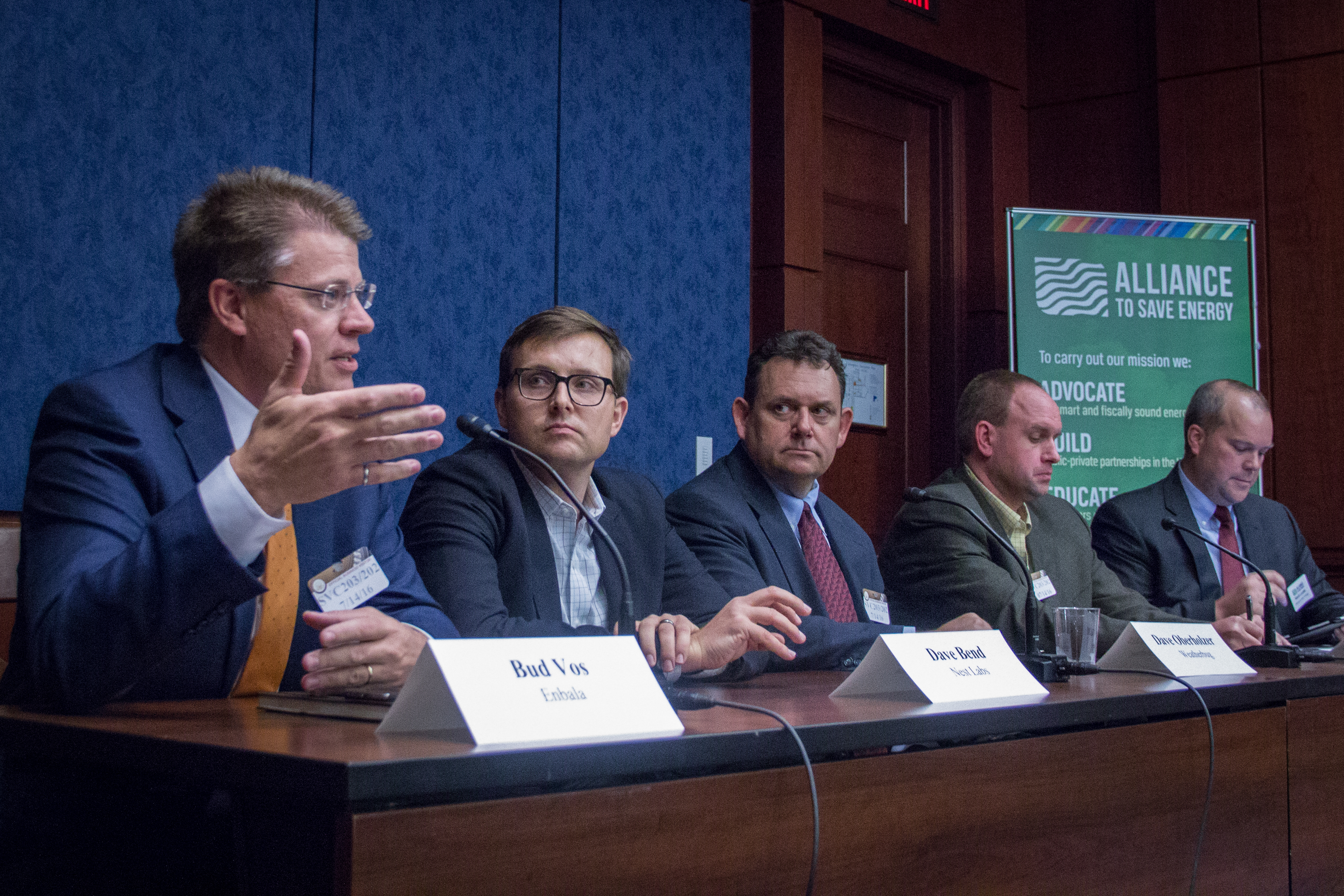The grid edge: ushering in an efficient, modern energy system
Let's Save Energy
Alliance to Save Energy's Blog

Does any low-hanging fruit remain for energy efficiency improvement? This was the question posed by Alliance to Save Energy president Kateri Callahan at the onset of our recent congressional briefing. The answer – reinforced by the perspectives of our event panel speakers – is a resounding yes. The fruit of the “grid edge” offers novel approaches to energy efficiency improvement. But this begs the question: what is the grid edge?
Depending on who you talk to, the grid edge could either be the future of a modern and efficient energy system or fizzle out like so many other ambitious concepts. The term “grid edge” refers to the hardware, software and business innovations that are increasingly enabling smart, connected infrastructure to be installed at the 'edge' of the power grid. The phrase “edge of the power grid” refers to the proximity to end-use customers (at their homes, businesses or at distribution systems very close to both) rather than at power plants or along transmission lines.
On July 14, we hosted our latest congressional briefing – Grid Edge: The Role of Energy Efficiency in a Modernizing Energy System – to explore the topic. Read on to learn about the perspectives of our panelists and stay tuned for more updates from the Alliance to Save Energy as grid-edge technologies continue to advance and evolve.
Supporting a modern energy system: what energy policies and regulations are needed?
With government leaders in the United States and around the world taking action to address energy and climate issues and the line becoming increasingly blurred between energy suppliers and users, panel moderator Kelly Speakes-Backman, the Alliance’s senior vice president of policy and research, asked panelists: What energy policies and regulations are needed to support a modern energy system?
According to Electric Drive Transportation president Genevieve Cullen, it is necessary for stakeholders to work together to advance technology and policies that allow electricity to power the economy. Cullen explained that the grid’s ecosystem needs to be flexible and that new players need to be recognized without being undermined – whether they be generators, storage participants or customers. Expanding upon this, Cullen explained that it is necessary for industry stakeholders to work together to advance technologies and policies that allow electricity to thrive as a power source. The blurring of lines in the power system is inevitable due to emerging technology, and the jurisdictional challenge of FERC and states reflects changes in the market and technology.
PG&E’s vice president of federal affairs and policy and chief sustainability officer Melissa Lavinson, whose company serves 16 million customers, made the important point that customers want to take control, be more engaged and be a part of the energy revolution. Further, Lavinson explained that in a world that’s becoming increasingly decarbonized and digitized, aligning incentives that encourage innovation and partnership to deploy grid edge innovations will be key. Lavinson explained that aligning regulatory structures – including incentive implementation and using scale to buy down cost – has been essential in making certain deployments successful. Pointing out that the system currently in place will eventually become untenable, Lavinson urged partners in the policy realm and regulatory structure to work closely with industry to accelerate the evolution of today’s integrated model.
Panelists agreed on the high value of education for stakeholders throughout the grid ecosystem. Cullen, describing the importance of education in overcoming energy obstacles, explained that customers benefit as power management information becomes increasingly available. Lavinson added that energy usage education is integral for PG&E, with big data and smart meters at the heart of their operations. Improvement of two-way communication helps everyone understand energy use, which can ultimately help encourage logical behavioral changes.
Keynote remarks: grid edge and utilities of the future
Providing keynote remarks for the event, David Nemtzow, acting director and senior strategist at the Building Technologies Office within the U.S. Department of Energy (DOE), brought up the often mentioned but nonetheless astounding fact that buildings account for 40 percent of energy use in the U.S. and 75 percent of electricity use. Nemtzow explained that there are many facets of efficiency that can be addressed to decrease buildings’ energy use. An example of this, he pointed out, is air conditioning. DOE is focusing an upcoming report on the topic, addressing the enormous amount of energy used by air conditioning, peak energy scenarios and refrigerant leaks – particularly relevant with the day’s briefing occurring during one of the hottest days of the season in Washington, D.C.
Nemtzow described the necessity of moving beyond the mindset of “we can” to “we will” in the field of grid edge. With the need for advanced sensors and controls, codes and standards can “lock in” the benefits of grid edge technology. Nemtzow pointed out that, in order to be successful in advancing opportunities available through the grid edge, we must be collectively smart and communicative. When we all consider how to manage and improve the grid and reduce carbon emissions, we can find success through innovation together.
How are advanced building technologies, distributed energy resources and connectivity impacting the grid edge?
Reflecting on how far we’ve come and the progress still to be made, the Alliance to Save Energy’s director of research, Kevin Lucas, opened the event’s second panel by posing a question to panelists: How are advanced building technologies, distributed energy resources and connectivity impacting the grid edge?
Discussing a complementary term for the grid edge, Joe Hagerman, senior policy advisor for the Building Technologies Office within the Department of Energy, described DOE’s focus on transactive energy and markets. Hagerman explained that as solutions emerge for increasing the efficiency of behind-the-meter technologies, DOE is keenly focused on ensuring the buildings-to-grid ecosystem remains robust and can attain scale with minimum interference. He discussed five main focus categories: characterization of connected equipment (a corollary to equipment standard test protocols), interoperability (convening market players to ensure equipment works together), cyber security (both high level (i.e. buildings and grid) and low level (i.e. device)), establishing valuation methods (monetizing advanced controls and equipment performance through markets), and core R&D (developing algorithms to better utilize controls and systems, working up to the scale of whole campuses).
Hagerman noted that the market will be key to solving the first four areas (although the federal government can help convene core institutional areas to help the market ‘solve’ the problems), but spoke more to DOE’s efforts in core R&D. Areas in which DOE is working include utilizing entire buildings as a “virtual battery” to reduce energy storage requirements, controlling loads to extend or reduce transformers losses and increase their lifetimes, and developing algorithms to optimize economic dispatch of building demand, site-installed distributed energy resources, and generation without impacting user comfort or operation.
Speaking to innovations in the building sector, Nest’s East Coast Energy Partnership’s David Bend, described Nest’s commitment to enabling the thoughtful home, using their motto to take care of the people inside of it and the world around it. After decades of certain home components appearing the be “unloved” by the buildings industry, Nest has focused on innovations that lower consumer utility bills and contribute to a more manageable grid. Now, according to Bend, consumers can enjoy improved energy performance from Nest sensors in the range of 15 percent savings on the warming side, and 12 percent on the cooling side. From a macro level, Nest is working with companies to produce seasonal savings.
Keying in on the benefits of connectivity and big data, Weatherbug vice president Dave Oberholzer shared an incredible fact: Weatherbug possesses over 10,000 sensors to gain insight into efficient use of energy based on weather and climate scenarios. As these sensors update data every 2.4 seconds, Weatherbug possesses a treasure trove of information that is invaluable in understanding how the components of the energy ecosystem can react efficiently to external weather conditions. Oberholzer explained that as the world becomes more and more connected, it makes sense to pursue the aggregation of data from thermostats, hot water heaters and washers/dryers.
Concluding the final panel of the event, Enbala CEO Bud Vos reiterated the importance of optimizing the energy system’s ecosystem. According to Vos, if we could figure out how to bring together the ecosystem of energy products, we could save gigawatts of energy. Further, Vos explained that software is the key to this optimization, the cornerstone of Enbala’s work. Upgradeable technology and open standards will move us along toward this optimization of the power system, with Vos noticing these trends already heavily underway.
STAY EMPOWERED
Help the Alliance advocate for policies to use energy more efficiently – supporting job creation, reduced emissions, and lower costs. Contact your member of Congress.
Energy efficiency is smart, nonpartisan, and practical. So are we. Our strength comes from an unparalleled group of Alliance Associates working collaboratively under the Alliance umbrella to pave the way for energy efficiency gains.
The power of efficiency is in your hands. Supporting the Alliance means supporting a vision for using energy more productively to achieve economic growth, a cleaner environment, and greater energy security, affordability, and reliability.



